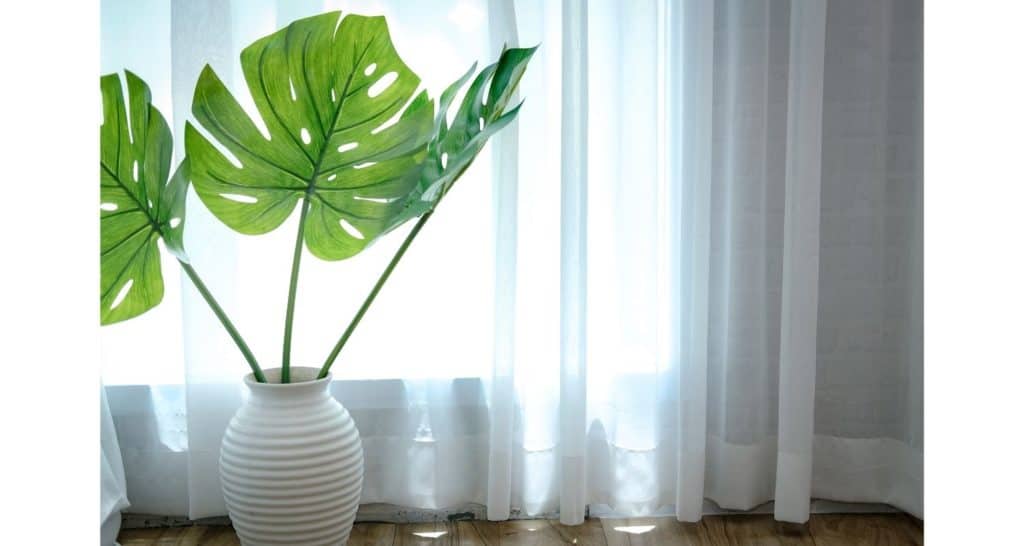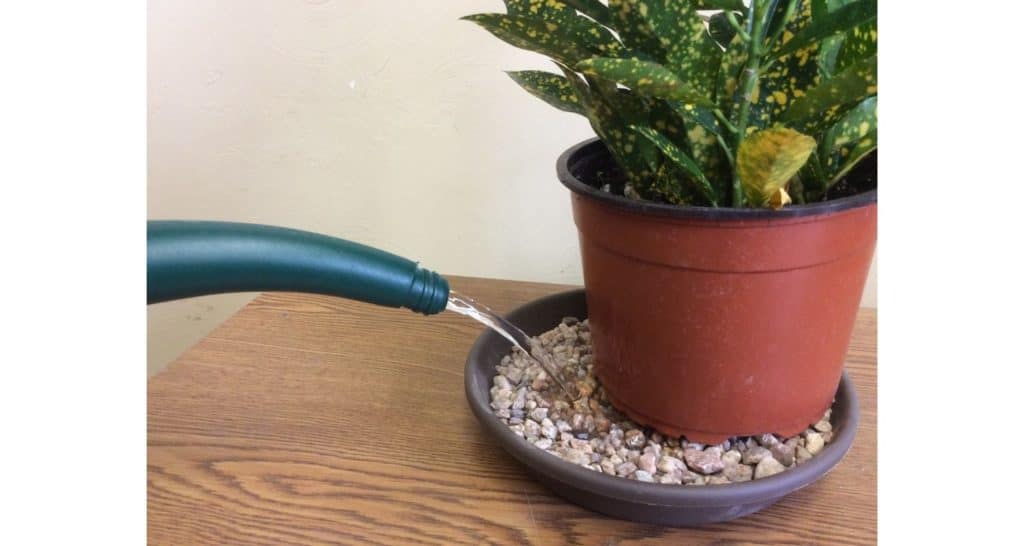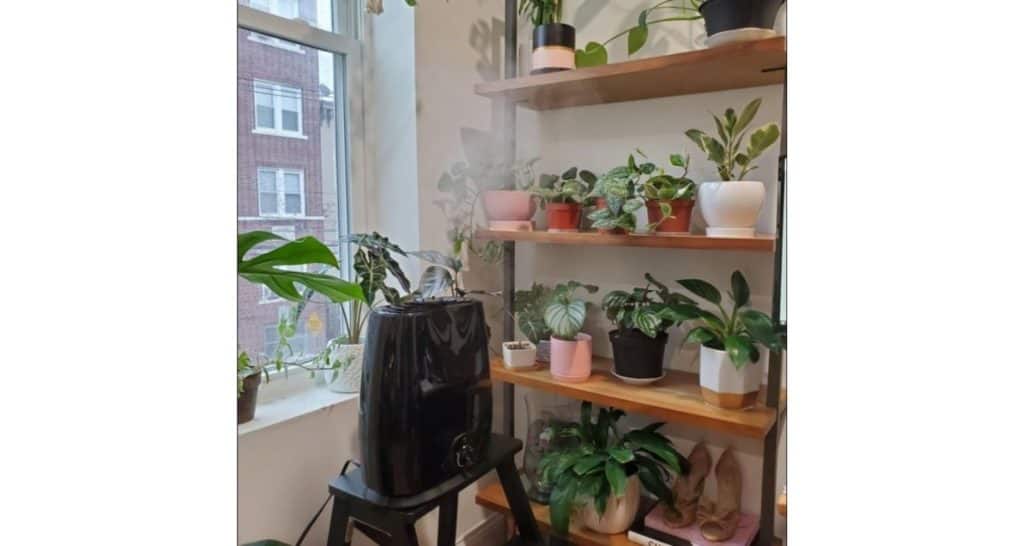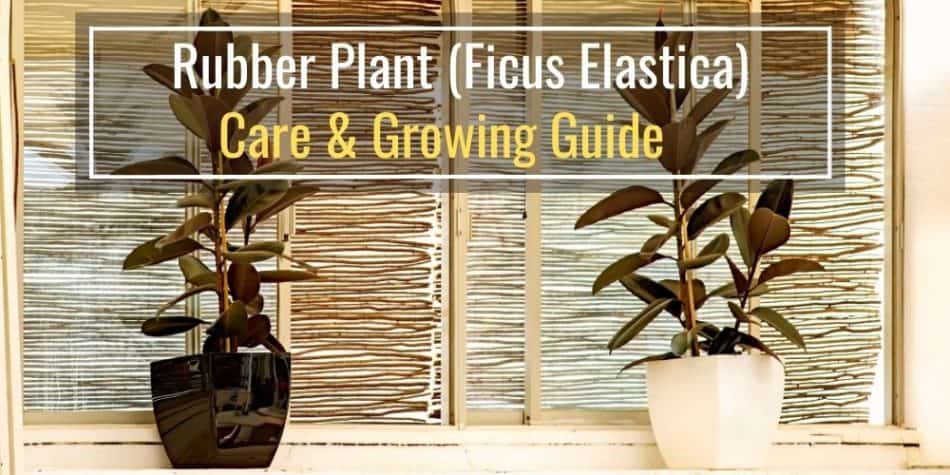The beautiful combination of alluring appearance, with a dose of exoticism, and ease of cultivation are big reasons why Ficus Elastica is such a well-liked and desired houseplant worldwide.
Native to tropical India, rubber plant trees from the Moraceae family can grow to an impressive 15 feet high with a trunk diameter of up to 6 feet.
Even when grown indoors, rubber plants can still grow into colossal plants that can reach the ceiling in a few years!
After all, the Latin name of the genus ‘Ficus’ is derived from the Greek word for ‘tree.’
Rubber Plant Profile
Unlike some other species from the same genus, Ficus elastica is a robust upright plant.
New leaves will emerge from a red tip of the stalk that slowly unwinds to reveal the big rubber like leaves. The leaves grow in an alternating pattern, are slightly elongated and oval, and can grow up to 9 inches long and about 4 inches wide.
Rubber tree leaf color can differ based on the specific variety, but the most common type has monochromatic glossy leaves in pure green.
There are more rare varieties with variegated leaves, such as the Ficus Elastica Decora, the variety with stunning dark green, light green, and cream white pattern, or a striking Ficus ElasticaTineke that has green and white foliage with a blush of pink or burgundy.
Regardless of which Rubber Plant variety you own, this guide will walk you through how to take care of your plant.
How To Care For The Rubber Plant
Ficus elastica is a common sight in homes and offices, proving that not all houseplants are difficult to care for.
Even though rubber plants are beginner friendly and hardy, we still need to provide the plant with its basic needs in order for this plant to survive.
Moreover, it’s best to provide the ideal conditions a rubber plant desires, such as the right light, soil, and temperature so your rubber plant can thrive.
Let’s cover the main factors that contribute to a healthy rubber plant.
Soil: What Is The Best Substrate For Rubber Trees?
For successful growth, this strong-rooted plant needs nutritious, porous and moist soil.
Similar to what a rubber tree would find in its native tropical climate, these plants prefer to have soil that drains well and remains moist but not wet.
In better-equipped garden centers, you can find ready-made mixtures specifically for ficus. However, you can also make a soil mixture for rubber plants.
Potting Mix Recipe For Rubber Plants:
Follow the ratios below in order to make a potting mix that is ideal for rubber plants:
- one part peat moss or potting substrate
- one part pine bark
- one part coarse sand or perlite
The bark, coarse sand, and perlite will allow for proper drainage while the peat moss will help retain moisture. Potting substrate or fertilizer will need to be added in order to provide nutrients to your plant.
Although rubber plants can grow in a pH-neutral substrate, rubber plants prefer soil with a slightly acidic pH of up to 7. That is why pine bark is added to the substrate.
Optionally, the same effect of maintaining mild acidity can be created by adding used coffee grounds to the substrate.
Water: Is The Rubber Tree A Thirsty Plant?
Watering schedules always depend on the season, pot size, plant size, humidity, and temperature.
Typically, you should water your plant once a week from spring to fall and twice a month in winter.
However, follow these steps in order to determine when to water a rubber plant:
- Insert your index finger into the soil 1 to 2 inches deep
- Feel for moisture
- Water if the soil is dry
- Do not water if the soil is wet or moist
Try to avoid using tap water. Most city waters contain chemicals such as chlorine and fluoride that can irritate and burn plant roots.
The best option is rainwater, but if you do not collect rainwater then allow tap water to sit inside a pot for a few hours before using it.
Allowing the tap water to rest will allow the hard minerals to sink to the bottom of the pot and for some of the chemicals to evaporate. Make sure not to pour the water near the bottom since this water will contain most of the hard minerals.
Light: Can Ficus Elastica Withstand Direct Sunlight?
Due to their leather-like appearance, ficus leaves might appear tough, but these leaves are sensitive to direct sunlight.
Rubber plant leaves exposed to direct sunlight, especially in the hottest part of the day, will quickly lose their shine, begin curling, and may even show visible signs of being sun burned.
Rubber Plants Prefer Bright Indirect Sunlight
Similar to most tropical house plants, rubber plant prefer areas where they can receive bright indirect sunlight.
The best windows are east or west facing windows since these receive a few hours of direct sunlight each day while receiving indirect sunlight the remainder of the day.
Rubber plants can tolerate slightly shady areas. However, rubber plants that do not receive enough light will grow at a much slower pace than a rubber plant that is receiving all the bright indirect sunlight it wants.
In the case of a rubber plant with variegated leaves, the leaves may turn even more white or pale as the plant is not receiving enough light to maintain the chlorophyll in its leaves which creates the green color.
Hang A Sheer Curtain To Transform Direct Sunlight Into Bright Indirect Light
If the Rubber Plant is receiving too much direct sunlight or you have a perfect spot for your rubber plant but it’s near a south facing window then you can hang a sheer curtain.
The sheer curtain will dim the sunlight’s intensity and transform the direct sunlight into bright indirect light.
Sheer curtains are transparent curtains that allow in a fair amount of light while blocking direct sunlight.

Most indoor houseplants thrive in indirect sunlight so this is a great option if you want to place other types of plants near the sunny south facing window.
Not to mention sheer curtains add a bit of privacy. Sheer curtains can be found on amazon in all colors and sizes.
Rotate your plant!
Even lighting throughout the day is tricky to achieve, even when it comes to a smaller plant such as the Rubber ficus.
So rotating the pot from time to time will prevent the plant from leaning or bending towards the light source.
Not only does rotating help the appearance of the plant so you can appreciate it from all angles, but rotating the plant will prevent the plant from overgrowing in one direction.
A rubber plant that is never rotated may grow too tall in one direction which can cause the plant to fall over and difficult to handle.
Humidity: Should I Mist The Rubber Plant?
Although the Rubber Plant can adapt to the average home humidity of 45% to 50%, the plant will grow better if the level of humidity is higher in the 60% to 90% range.
Increasing the humidity for a rubber plant can be achieved by using one of the following methods:
- Misting the plant with a spray bottle
- Placing the plant on top of a pebble tray
- Using a humidifier
So misting a rubber plant is beneficial since it increases the humidity for the plant as well as washes off any dust and particulates that may have fallen on its leaves.
Misting is a great option, however, it is a bit laborious if you plan on misting the rubber plant 3 to 4 times per week.
Personally, I’m too lazy to frequently mist my plants, so I use pebble trays and humidifiers to increase the humidity for my tropical house plants.
Simple DIY Humidifier: Pebble Tray
Pebble trays are a simple and effective solution to providing more humidity to plants. A pebble tray is exactly what it sounds like – a tray full of pebbles.
Most house plants, including Rubber Plants, are tropical plants that can grow better in a humid environment.

In order to make a pebble tray:
- Select a shallow tray that is larger than the base of the plant’s pot
- Fill the tray with a single layer of pebbles
- Add water so it rises to about halfway up the rocks
That’s it! You have now created a simple but effective pebble tray for increasing humidity.
Next just place your plant on top of the pebbles and add water to your tray if it ever dries out.
Humidifier: Easy Way To Increase Room’s Humidity
One simple solution is to periodically mist your indoor houseplants to increase the humidity. However, this is manual and, personally, I’m too lazy to continually spray my plants every so often.
An easier solution is to place a humidifier in the room with all of your tropical plants. A humidifier will allow you to adjust the settings to provide the right amount of humidity year round.

I use this humidifier in my room and the water reservoir lasts for about 2 days before needing to be refilled. I highly recommend it for a low maintenance way of keeping the room humid for your houseplants.
Temperature: Does Rubber Fig Need High Temperatures?
Rubber plants are great beginner friendly plants since these plants prefer temperatures in the 65°F to 85°F range.
This means rubber plants prefer temperatures at which most people set their internal home temperatures at. So whichever temperature makes you feel comfortable will also make this plant feel comfortable.
However, do not keep this plant in an unheated room during the winter if the temperature can drop below 50°F. Temperatures below 50°F will cause irreversible damage to a Rubber Plant.
Also try to provide consistent temperature to a Rubber Plant since it does not like sudden temperature changes.
Drafty walkways, windows, air vents, and radiators are all poor locations to place a Rubber Plant since the temperature may fluctuate in these locations.
Sudden temperature changes will cause stress on a Rubber Fig, which can result in curling leaves and the leaves to fall off.
Fertilizing: How Often Should I Feed My Rubber Plant?
Ficus Elastica needs regular fertilization since its large root consumes nutrients in the substrate relatively fast.
From spring to autumn, a rubber plant can be fertilized as often as once a month with liquid fertilizer or a slow-release fertilizer in the form of sticks or granules.
Young ficus plants need a fertilizer with an increased phosphate content, which will stimulate root development with N-P-K (10-16-10). The following season, use a fertilizer with increased nitrogen content with N-P-K (24-8-16) since it stimulates the development of leaf mass and the entire aboveground part of the plant.
Natural Fertilizer Alternatives
Instead of using chemically composed fertilizers, you can use natural fertilizers such as mature compost or worm casting for the same effect.
One handful of natural fertilizer added to the substrate in spring will be enough to provide the necessary nutrients till the end of the season.
Coffee grounds are also a good amendment to soil.
Repotting: How Often To Transplant Rubber Plants?
Rubber plants should be transplanted or repotted every year. Repotting a rubber plant allows you to place the plant into a slightly larger pot so that the roots have room for new growth.
The other benefit to repotting a rubber plant each year is that you can place new soil into the pot. This will ensure that the plant has all the nutrients it needs from its soil to continue to grow.
Make sure to use stable or wide pots so that the rubber tree does not fall over as the plant grows taller.
My Ficus Elastica Is 5 Feet Tall! How To Transplant It?
Transplanting or repotting larger Rubber Plants can be a daunting endeavor. A better option is to just replace the surface layer soil with new soil. For example, remove 3 to 4 inches of substrate off the top and replace it with fresh substrate.
This method can be repeated until the roots of the larger Rubber Plants start to become visible near the surface. Once the roots start protruding near the top of the soil then the plant needs to be repotted.
Propagating: Is The Rubber Ficus Easy To Propagate?
The easiest way to propagate a rubber ficus is by using cuttings that you can root in water or directly in the substrate.
In late spring or early summer, take a cutting at least 3 to 6 inches long and remove the lower leaves so that only two or three leaves remain on the top.
Place the cutting into a prepared mixture of peat and sand or place the cutting in a glass of water.
Store the cutting a warm that receives bright indirect sunlight. In two to three weeks the cuttings will be ready for transplanting into a separate pot as completing new rubber plants!
Air Layering For Propagating Rubber Plants
Air layering is a somewhat unusual way of propagating that will give you new plants. Not to mention air layering is also an effective way to renew the existing or mother plant.
Follow these steps in order to successfully propagate a rubber plant by air layering.
- In early summer, notch into half a branch that is at least as thick as a finger using a sharp, clean knife.
- Coat the cut place with moss and wrap everything together with transparent plastic foil.
- Keep the moss moist at all times, and in a few weeks at the notch site, the new roots will appear.
- When they are noticeable through the plastic foil, cut that part just below the foil, unpack the root and plant it as a separate plant.
Common Problems: What Is Wrong With My Rubber Plant?
A: Rubber ficus is a low maintenance plant, and all the problems that may occur are mainly related to improper plant treatment or environment. The most common reasons for issues with a Rubber Plant are not enough water, too much or too little light, placing the plant near an air vent, or excessively fertilizing the plant.
Q: Why Do Rubber Ficus Leaves Fall?
A: The most common reason for ficus leaves to fall are low humidity levels, air drafts, cold room temperature, insufficient watering, or having the soil too wet for too long.
Q: Why Does My Rubber Plant Have Brown And Yellow Spots On The Leaves?
A: The accumulation of water around the roots due to excessive watering or impermeable soil will cause brown and yellow spots on the leaves. If the rubber plant is not being overwatered then make sure that the plant is not receiving too much direct sunlight. Simply place the rubber plant in an area further away from the window and the leaves should start to return to their original color.
Q: Why Does My Rubber Plant Have Crispy And Inwards Curled Leaves?
A: Underwatering is the most common reason for crispy and curling leaves. The rubber plant is trying to conserve as much water as possible when experiencing a drought so the leaves will not receive enough moisture in order to remain flat. Make sure to water the rubber plant consistently in order to prevent the leaves from curling and turning crispy.
Q: Why Does My Plant Have Yellowing And Wilted Lower Plant Leaves?
A: The most common reason for yellowing and wilted lower leaves on a rubber plant is from overfertilizing. If the rubber plant has yellowing and wilted lower leaves then do not fertilize the plant for 1 month.
Q: What Is Eating My Rubber Plant?
A: Mealybugs, aphids, spider mites, and scale insects are the common pests that can occasionally attack the Rubber plant. These pests pierce the plant tissue and suck the cell sap leaving speckled or striped leaves as they remove chlorophyll.
If you notice these unwanted guests, act at once since they spread quickly and easily to other nearby plants. You can try to rinse them off with lukewarm water. If that does not get the desired result, you can apply some homemade remedies to control pests.
Frequently Asked Questions:
Q: Is Ficus Elastica Poisonous?
A: The sap of ficus leaves contains some enzymes that can cause skin irritation and stomach problems if they get into the digestive tract. However, it will not cause severe health issues for either humans or pets.
Q: Can I Place My Rubber Plant In The Bedroom?
A: Rubber plants can be placed in the bedroom, however, there are better plants to place in the bedroom from an air quality perspective.
In daytime, Rubber Plants release oxygen as part of its phytological processes and, thus, enriches the air we breathe. At night, however, the process is reversed, and the Rubber Plant takes oxygen from the surroundings and releases carbon dioxide.
For this reason, Rubber Plants are not the best plants to place in the bedroom especially if the bedroom is small. Choose plants with the reverse rhythm where they release oxygen at night, such as a snake plant (sansevieria).
Q: Why Is The Plant Called A Rubber Tree?
A: If you think that the epithet rubber, in the name of this plant, is associated with its shiny rubbery leaves then guess again! The Rubber Plant received its name because it extracts thick white latex sap, which is used to produce rubber.
Q: Does The Rubber Plant Bloom?
A: Rubber Plants do bloom but it seldom happens with indoor plants.
Even if a Rubber Plant did bloom, you wouldn’t miss much if you never see its flowers, because they do not look like flowers at all. Rubber Plant’s flowers are more like fake fruits, within which, by pollination, a small inedible fruit resembling a small fig is formed.
Among other things, these small fruits are the reason why this plant is also called Rubber Fig!
Q: Should I Prune My Rubber Plant?
A: Rubber Plants can be pruned in order to maintain a desirable height or shape. To keep a Rubber Plant a certain height, simply cut off the top part of the plant. Make sure to cut just below the node where the leaf attaches to the stem or where another stem branches off.
This will stimulate lateral new shoots to grow and will help fill out the plant.
Rubber Plants can be pruned at any time of the year, but the plant will respond best to pruning in the early summer such as June.
Q: Do Rubber Tree Plants Clean The Air?
A: Rubber Tree Plants do in fact clean the air. Not only do Rubber Plants eliminate toxins from the air but they also effectively remove mold spores and bacteria by up to 60%.
Final Thoughts
When you buy a Rubber fig, it is usually a plant about of only 15 to 20 inches high with 5 to 8 leaves. If one or two leaves fall off shortly afterward, it does not necessarily mean you did something wrong. Changing conditions always causes stress in Ficus.
Keep that in mind, and when you find a place where the Rubber Plants grows nicely then try to not move the plant often.
Make sure to provide Rubber Trees with enough space to grow since this small plant can turn into a giant with the proper environment and time.
Before you know it, your tiny Rubber Plant may grow into a Rubber Tree.

